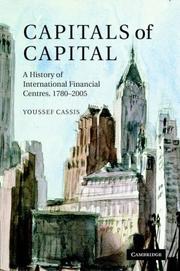| Listing 1 - 2 of 2 |
Sort by
|
Multi
ISBN: 9781108421256 9781108367677 1108421253 9781108431651 1108373135 1108367674 1108369359 1108431658 Year: 2020 Publisher: Cambridge Cambridge University Press
Abstract | Keywords | Export | Availability | Bookmark
 Loading...
Loading...Choose an application
- Reference Manager
- EndNote
- RefWorks (Direct export to RefWorks)
Why do stock and housing markets sometimes experience amazing booms followed by massive busts and why is this happening more and more frequently? In order to answer these questions, William Quinn and John D. Turner take us on a riveting ride through the history of financial bubbles, visiting, among other places, Paris and London in 1720, Latin America in the 1820s, Melbourne in the 1880s, New York in the 1920s, Tokyo in the 1980s, Silicon Valley in the 1990s and Shanghai in the 2000s. As they do so, they help us understand why bubbles happen, and why some have catastrophic economic, social and political consequences whilst others have actually benefited society. They reveal that bubbles start when investors and speculators react to new technology or political initiatives, showing that our ability to predict future bubbles will ultimately come down to being able to predict these sparks.
Business cycles --- International finance --- International economic relations --- Financial crises --- Business forecasting. --- History. --- Business forecasting --- History --- Business --- Business forecasts --- Forecasting, Business --- Economic forecasting --- Crashes, Financial --- Crises, Financial --- Financial crashes --- Financial panics --- Panics (Finance) --- Stock exchange crashes --- Stock market panics --- Crises --- Forecasting --- 331.162.1 --- 333.645 --- Geschiedenis van de financiële markten --- Speculatie op de beurs --- Business cycles - History --- Financial crises - History

ISBN: 9780521845359 0521845351 9780511607424 0511334648 9780511334641 9780511335228 0511335229 0511607423 1281040290 9781281040299 1107164117 9786611040291 1139131036 0511333307 0511333986 Year: 2006 Publisher: Cambridge Cambridge University Press
Abstract | Keywords | Export | Availability | Bookmark
 Loading...
Loading...Choose an application
- Reference Manager
- EndNote
- RefWorks (Direct export to RefWorks)
International financial centres have come to represent a major economic stake. Yet no historical study has been devoted to them. Professor Cassis, a leading financial historian, attempts to fill this gap by providing a comparative history of the most important centres that constitute the capitals of capital - New York, London, Frankfurt, Paris, Zurich, Amsterdam, Tokyo, Hong Kong, Singapore - from the beginning of the industrial age up to the present. The book has been conceived as a reflection on the dynamics of the rise and decline of international financial centres, setting them in their economic, political, social, and cultural context. While rooted in a strong and lively historical narrative, it draws on the concepts of financial economics in its analysis of events. It should widely appeal to business and finance professionals as well as to scholars and students in financial and economic history.
Histoire économique et sociale --- --Finance --- --1780-2005 --- --Banques internationales --- 336.71 <09> --- 333.601 --- -332.1 --- Bankwezen--Geschiedenis van ... --- Organisatie van de financiële markten. --- 336.71 <09> Bankwezen--Geschiedenis van ... --- AA / International- internationaal --- 331.162.1 --- 333.600 --- Financial institutions, International --- International financial institutions --- International finance --- Geschiedenis van de financiële markten. --- Financiële markten. Kapitaalmarkten (algemeenheden). --- History --- World history --- anno 1700-1799 --- anno 1800-1999 --- anno 2000-2009 --- --Banks and banking --- Finance --- History. --- Banks and banking, International --- Cities and towns --- Banques internationales --- Villes --- Growth --- Economic aspects. --- Histoire --- Croissance --- Aspect économique --- --336.71 <09> --- Banks and banking --- Bankwezen--Geschiedenis van .. --- Geschiedenis van de financiële markten --- Financiële markten. Kapitaalmarkten (algemeenheden) --- Organisatie van de financiële markten --- --Financial institutions, International --- Bankwezen--Geschiedenis van . --- Arts and Humanities --- Bankwezen--Geschiedenis van --- -History
| Listing 1 - 2 of 2 |
Sort by
|

 Search
Search Feedback
Feedback About UniCat
About UniCat  Help
Help News
News